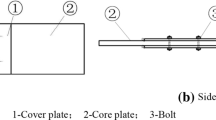Abstract
To avoid the failure at bolted connections and ensure fire resistance at elevated temperature, this study examines the effect of end distance and bolt number on the bearing behavior of bolted connection from experimental results. In addition, numerical analysis is performed to evaluate the stress distribution at bolt hole with varied end distance at different temperature levels and to investigate the influence of stress concentration in longer joints. Based on the results of this study, it is found that the bearing strength increases linearly with end distance up to the value of 4d. And both AISC and Eurocode 3 underestimate the bearing stregnht of bolted plates at elevated temperature. A linear function of end distance is proposed for the bearing strength of bolted connections. The reduction factor for shear lag effect of AISC is recommended to modify the bearing strength for longer connections. It is also suggested to increase the end distance 3d to prevent tear-out failure at elevated temperature.
Similar content being viewed by others
References
Al-Jabri, K. S., Davison, J. B., and Burgess, I. W. (2008). “Performance of beam-to-column joints in fire — A review.” Fire Safety J., 43, pp. 50–62.
AISC (2005). Load and resistance factor design specifications for structural steel buildings. 2 nd Ed., American Institute of Steel Construction, Chicago, IL.
ANSYS (2012). ANSYS Workbench user manual. ANSYS Inc., USA.
CNS 3934 (1998). Mechanical properties of bolts, screws, and studs. M.O.I., Taipei, Taiwan.
Eurocode 3 (2005a). Design of Steel Structures. Part 1.2: General Rules-Structural Fire Design. European Committee for Standardization, Brussels, Belgium.
Eurocode 3 (2005b). Design of Steel Structures. Part 1.8: Design of joints. European Committee for Standardization, Brussels, Belgium.
Fisher, J. W. and Rump, J. L., (1965). “Analysis of bolted butt joints.” Journal of the Structural Division, ASCE, 91(5), pp. 181–203.
Hsu, C. F. (2013). Behavior of bolted connections at elevated temperature, Master Thesis, National Kaohsiung First University of Science and Technology, Kaohsiung, Taiwan.
Hu, Y., Davison, J. B., Burgess, I. W., and Plank, R. J. (2009) “Component modelling of flexible end-plate connections in fire.” International Journal of Steel Structures, 9(1), pp. 1–15.
JSSC (1981). Sets of torque-shear-type high-strength bolt, hexagon nut and plain washer for structural joints. Soc. of Steel Construc. of Japan, Tokyo, Japan, pp. 1–23 (in Japanese).
Kim, H. J. and Yura, J. A. (1999). “The effect of ultimate-to-yield ratio on the bearing strength of bolted connections.” J. Construc. Steel Res., 49, pp. 255–269.
Kirby, B. R. (1995). “The behavior of high-strength Grade 8.8 bolts in fire.” J. Construct. Steel Res., 33, pp. 3–38.
Kulak, G. L., Fisher, J. W., and Struik, H. A. (1987). Guide to Design Criteria for Bolted and Riveted Joints. John Wiley & Sons, Inc., USA.
Perry, W. C. (1981). The bearing strength of bolted connections. Master Thesis, The University of Texas at Austin, Texas, USA.
Ramli Sulong, N. H., Elghazouli, A. Y., and Izzuddin, B. A. (2007). “Behaviour and design of beam-to-column connections under fire conditions.” Fire Safety J., 42, pp. 437–451.
Sarraj, M., Burgessa, I. W., Davison, J. B., and Plank, R. J. (2007). “Finite element modeling of steel fin plate connections in fire.” Fire Safety J., 42, pp. 408–415.
Tan, K. H. and Huang, Z. F. (2005). “Structural responses of axially restrained steel beams with semirigid moment connection in fire.” J. Struct. Eng., 131(4), pp. 541–551.
Wang, Y. C., Dai, X. H., and Bailey, C. G. (2011). “An experimental study of relative structural fire behaviour and robustness of different types of steel joint in restrained steel frames.” J. Construct Steel Res., 67, pp. 1149–1163.
Wei, C. and Jihong, Y. (2012). “Mechanical properties of G550 cold-formed steel under transient and steady state conditions.” J. Construc. Steel Res., 73, pp. 1–11.
FEMA 403 (2002). World Trade Center Building Performance Study: Data collection, preliminary observations and recommendations. Technical Report FEMA 403, Federal Emergency Management Agency, Washington, DC.
Yang, K. C., Chen, S. J., and Ho, M. C. (2009). “Behavior of beam-to-column moment connections under fire load.” J. Construct Steel Res., 65, pp. 1520–1527.
Yang, K. C., Hsu, R. J., and Chen, Y. C. (2011). “Shear strength of high-strength bolts in fire.” Building and Constructional Materials, 25, pp. 3656–36603-APR-2011.
Author information
Authors and Affiliations
Corresponding author
Additional information
Note.-Discussion open until May 1, 2014. This manuscript for this paper was submitted for review and possible publication on October 14, 2012; approved on October 1, 2013.
Rights and permissions
About this article
Cite this article
Yang, KC., Hsu, RJ. & Hsu, CF. Effect of end distance and bolt number on bearing strength of bolted connections at elevated temperature. Int J Steel Struct 13, 635–644 (2013). https://doi.org/10.1007/s13296-013-4005-y
Published:
Issue Date:
DOI: https://doi.org/10.1007/s13296-013-4005-y




